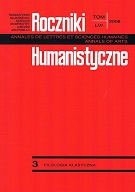Kilka uwag o Medei Eurypidesa
Notes on Euripides’ Mede
Author(s): Magdalena MajewskaSubject(s): Language and Literature Studies
Published by: Towarzystwo Naukowe KUL & Katolicki Uniwersytet Lubelski Jana Pawła II
Keywords: Euripides; Medea; Greek theatre; scenic action; spectacle; woman in the classical theatre; character’s portrait; Eurypides; teatr grecki; akcja sceniczna; widowisko; kobieta w teatrze klasycznym; portretowanie postaci
Summary/Abstract: This paper attempts to characterise the heroine of the Euripides’ play through her murderous plan and scenic presence. Medea organizes every stage action and spreads out the emotional control of secondary characters and scenic events with her strong and almost manly personality. The meaningful feature to observe is that she does not leave the scene since her first entrance till the exit in order to kill the children, so she can be in the centre and be the centre of the scenic situation in the major part of the spectacle. In the first part of the paper we observe, with a special attention paid to what elements of her personality help her to reach what she wants, how Medea creates her revenge plan in details and in the full view of the spectators. Step by step she builds up its points: she wins one day longer in Corinth, gets from Aigeus an asylum in Athens (this episode is the subject matter of the second part of the paper), persuades Jason to let the children give her gifts to the princess. The final point is to kill her sons. The last passage focuses on the effect of Medea’s two entrances, both significant from a theatrical and a dramatic point of view. The first entrance brings her continuous presence and her control of the whole action to the stage. The other one, at the end of the play—followed by the spectacular escape in the Helios’ chariot, with her godlike appearance when she establishes the institution of the worship and prophesies the future events—shows that her control influences not only what is present but also what is future. All that depicts Medea as a central character in the play, focusing the emotional tension and the scenic effect on herself, manipulating to a large extent stage events and directing their development into the final realization of her intentions.
Journal: Roczniki Humanistyczne
- Issue Year: 56/2008
- Issue No: 03
- Page Range: 53-75
- Page Count: 23
- Language: Polish

